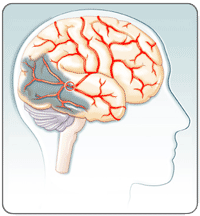
Cerebro Vascular Disease
It is a group of brain dysfunctions related to the diseases of blood vessels, supplying the brain.Hypertension is the most important cause; it damages the blood vessels lining. Sustained hypertension permanently changes the architecture of blood vessels, making them stiff, narrow, deformed, uneven and more vulnerable to fluctuation in blood pressure. A sudden rise in blood pressure due to excitation can cause tearing of blood vessels resulting in intracranial hemorrhage.
Cerebrovascular disease primarily effects people who are elderly or have a history of Diabetes, smoking or ischemic heart disease. The results of CVD can include a stroke or occasionally a hemorrhagic stroke.
Cerebro-vascular accident (Stroke). A stroke happens when the blood supply to the brain is disturbed in some way. As a result, brain cells are starved of oxygen. This causes some cells to die and leaves other cells damaged.
Types of Stroke:
i) Transient ischemic attack
ii) Cerebral Thrombosis
iii) Cerebral embolism
iv) Cerebral Hemorrhage
An artery to the brain may be blocked by a clot thrombosis which typically occurs in a blood vessel that has previously been narrowed due to atherosclerosis (Hardening of the artery) when a blood clot or a piece of an atherosclerotic plaque (a cholesterol & calcium deposit on the wall of the artery) breaks loose, it can travel through the circulation and lodge in an artery of the brain, plugging it up and stop the flow of blood, this is an embolic stroke.
A blood clot can form in a chamber of the heart when the heart beats irregularly, as in arterial fibrillation, such clots usually stay attached to the inner lining of the heart but they may break off, travel through the blood stream, form a plug (embolus) in a brain artery and cause a stroke. A cerebral hemorrhage (bleeding in the brain) as from an aneurysm (a widening and weakening) of a blood vessel in the brain also causes stroke.
In some Demyelinating diseases: (Loss of myelin sheath)
i) Multiple sclerosis
ii) Acute demyelinating Encephalomyelitis.
In Multiple sclerosis- may cause hemiplegic (Paralysis of one side of the body) facial palsy. The signs depend on the site of the demyelinating lesion. Paralysis may be unilateral but usually become bilateral as the disease progresses.
In acute demyelinating Encephalomyelitis: Headache, Vomiting, Pyrexia and Delirium are common presenting features and signs of meningeal irritation may also be found. Fits or coma may occur, flaccid paralysis and extensor planter responses are common but sensory loss is unusual.
There are many other nervous system disorders that can mimic a stroke including a i) brain tumour ii) subdural hematoma iii) Viral infection of the brain (Viral encephalitis) iv) brain abscess v) dehydration or an imbalance of sodium, calcium or glucose can cause neurologic abnormalities similar to a stroke.
In sever hypertension, Vessels so affected and rupture to cause bleeding into the brain. Majority of intracerebral hemorrhage occur in the region of internal capsule-There may be premonitory severe headache and in over a half of patients there is loss of consciousness, sometimes accompanied by an epileptic fit, since the internal capsules is so frequently involved, a hemiplegic (Paralysis) commonly supervenes and initially may be of the flaccid type.
Common symptoms of stroke:
It depends on which area of the brain is damaged because different parts control different abilities such as speaking, memory, swallowing and moving. Most common signs of a stroke are-
Weakness of one side of the body ranging from numbers to paralysis that can affect the arm and leg.
Weakness one side of the face, drooping of mouth
Loss of muscle coordination or balance
Severe headache
Confusion
Swallowing may be affected
Speech may be difficult or become difficult to understand.
In severe condition-Patient may lose consciousness
Risk Factors:
i) high blood pressure-does not cause any symptom so everyone has to check her/his blood pressure over the age of 40yr.
ii) Smoking-have double risk of stroke in comparative to non smokers.
iii) Diabetes-have to attention on diet, regular blood test and urine test.
Irregular heart beat: (atrial fibrillation) is common in old age. It increases the risk of stroke by causing blood clots to form in the heart.
Too much alcohol – increase the risk of stroke.
Obesity – increase the risk of stroke.
According to Ayurveda – 80 Vata vyadhis, 40 Pitta vyadihis, 20 Kapha vyadihis explained in Ayurveda.Vata vyadhi mainly caused by high involvement of Vata dosha. Vata vyadhi can be understand for neurological and musculoskeletal disease. Neurological diseases associated with Avrita dosha condition especially stroke is caused by acute (Avrita Vata) can be classify depending upon the lakshanas.
Treatment-In Modern view
1) Treatment of high blood pressure
2) Blood glucose level in diabetes is often quite high after a stroke, control of glucose is necessary.
3) Drugs that dissolves the blood clot
4) Anticoagulants
5) O2 given as needed.
According to Ayurveda: first the person has to control risk factors i.e. high blood pressure, blood sugar, alcohol, smoking by diet and life style. Panch karma and kerala therapies are quite effective along with oral medication and physiotherapy.aim of these therapies-to toning up tissues and to reduce the destructive and degenerative process, rejuvenate the body, enhance a total positive health.
In some condition patients get depression so counseling gives a positive response.
Pizhichil – warm medicated oil pour all over the body along with full body massage. Concentrate on effected area. It improves the tone of the muscles.
Sirodhara – It helps to dissolve the blood clot, improve the circulation, reduces stress factor.
Vasthi – Ayurveda considered Vasthi chikitsa as ardha chikitsa of all diseases. It is very effective treatment for vataja Roga and also in all vataja vyadhi
Pichu – apply in affected areas.
Nasyam – It is very important and useful treatment in all types of Shiro rogas. It is prime treatment in facial paralysis.
Navrakizhi – Nourishes the muscles. It prevents muscle wasting, enriches the tonicity.

